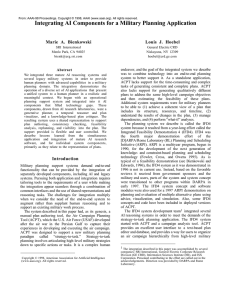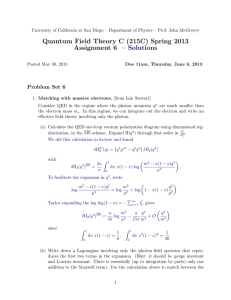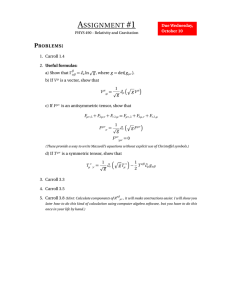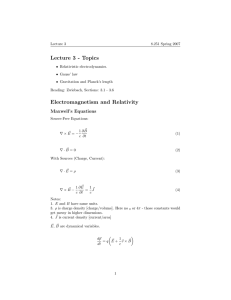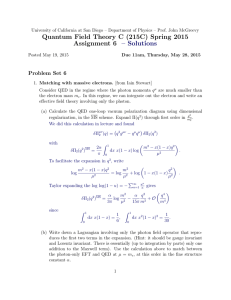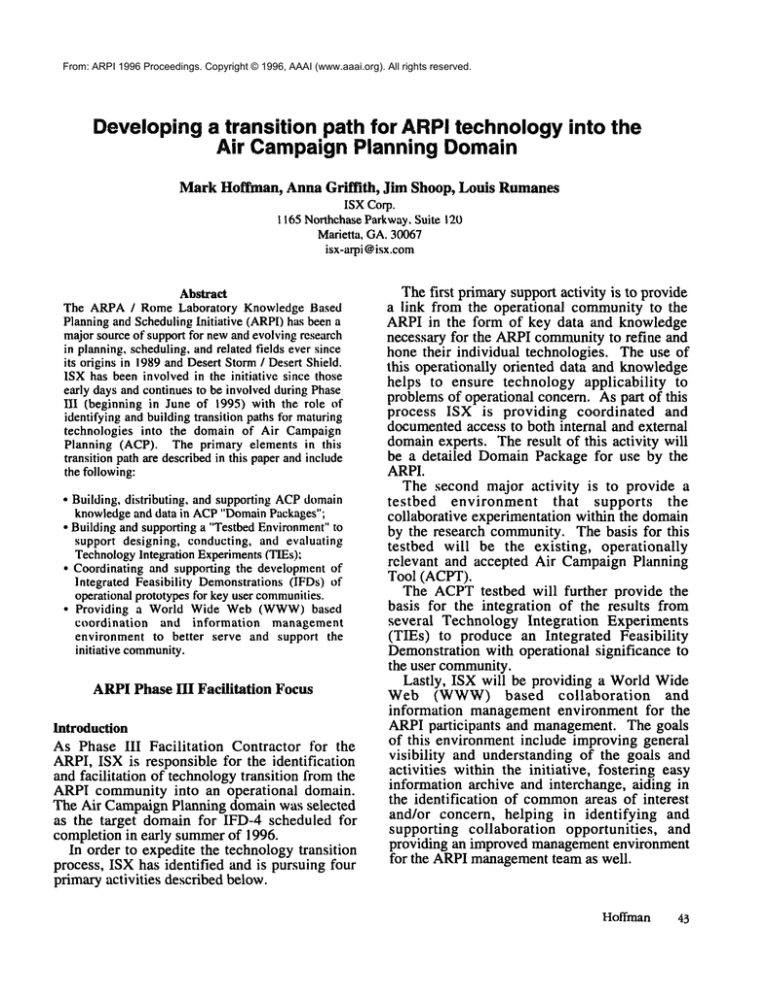
From: ARPI 1996 Proceedings. Copyright © 1996, AAAI (www.aaai.org). All rights reserved.
Developinga transition path for ARPItechnologyinto the
Air CampaignPlanning Domain
MarkHoffman, AnnaGriffith,
Jim Shoop, Louis Rumanes
ISX Corp.
1165 Northchase Parkway. Suite 120
Marietta, GA.30067
isx-arpi @isx.com
Abstract
The ARPA/ Rome Laboratory Knowledge Based
Planning and Scheduling Initiative (ARPI) has been
major source of support for new and evolving research
in planning, scheduling, and related fields ever since
its origins in 1989 and Desert Storm / Desert Shield.
ISX has been involved in the initiative since those
early days and continues to be involved during Phase
III (beginning in June of 1995) with the role
identifying and building transition paths for maturing
technologies into the domain of Air Campaign
Planning (ACP). The primary elements in this
transition path are described in this paper and include
the following:
¯ Building, distributing, and supporting ACPdomain
knowledge and data in ACP"DomainPackages";
¯ Building and supporting a "Testbed Environment"to
support designing, conducting, and evaluating
TechnologyIntegration Experiments (TIEs):
¯ Coordinating and supporting the development of
Integrated Feasibility Demonstrations (IFDs)
operational prototypes for key user communities.
¯ Providing
a World Wide Web (WWW)based
coordination and information management
environmentto better serve and support the
initiative community.
ARPIPhase III Facilitation Focus
Introduction
As Phase III Facilitation Contractor for the
ARPI, ISX is responsible for the identification
and facilitation of technologytransition from the
ARPI community into an operational domain.
The Air CampaignPlanning domain was selected
as the target domain for IFD-4 scheduled for
completion in early summerof 1996.
In order to expedite the technology transition
process, ISX has identified and is pursuing four
primary activities described below.
Thefirst primarysupport activity is to provide
a link from the operational communityto the
ARPI in the form of key data and knowledge
necessary for the ARPIcommunityto refine and
hone their individual technologies. The use of
this operationally oriented data and knowledge
helps to ensure technology applicability
to
problemsof operational concern. As part of this
process ISX is providing coordinated and
documentedaccess to both internal and external
domainexperts. The result of this activity will
be a detailed DomainPackage for use by the
ARPI.
The second major activity is to provide a
testbed environment that supports the
collaborative experimentation within the domain
by the research community.The basis for this
testbed will be the existing, operationally
relevant and accepted Air Campaign Phmning
Tool (ACPT).
The ACPTtestbed will further provide the
basis for the integration of the results from
several Technology Integration Experiments
(TIEs) to produce an Integrated Feasibility
Demonstration with operational significance to
the user community.
Lastly, ISX will be providing a World Wide
Web (WWW) based collaboration
and
information management environment for the
ARPIparticipants and management. The goals
of this environment include improving general
visibility and understanding of the goals and
activities within the initiative, fostering easy
information archive and interchange, aiding in
the identification of commonareas of interest
and/or concern, helping in identifying and
supporting collaboration opportunities, and
providing an improved managementenvironment
for the ARPImanagementteam as well.
Hoffman
43
From: ARPI 1996 Proceedings. Copyright © 1996, AAAI (www.aaai.org). All rights reserved.
A primary driver for the development of the
Phase Ill plan were the lessons learned from the
earlier phases of the ARPI. These lessons
included:
¯ The need to provide the ARPI participants
direct access to a broad range of domain
experts, leveraging the results of these
activities backto the initiative as a whole.
¯ The need to let the community drive the
requirements and thus, to a large extent, the
design for the collaboration environment.
¯ The need to formally identify, support, and
evaluate Technology Integration Experiments
as a primary, scheduled aspect of the
initiative.
¯ The need to identify and dynamically manage
the "balance point" between the desire for
technology insertion and the user community
interest in a robust, focused solution to an
operationally significant problem.
Theworkdescribed in this paper represents the
plannedactivities for ISXduring PhaseI11 of the
ARPI and the first
4 months of that
implementation. As such, muchof the described
plan has not been executed and thus, the plan and
its implementationwill evolve over the course of
the ARPI.
Domain Package Support
Because of prior experience in the Air Campaign
Planning (ACP) domain, ISX Corporation
providing
the ARPI community with an
accumulation of years of experience in this
domain. Over the past three years, ISX has
established relationships with experts in the field
and augmented our own staff with ACPdomain
experts. These experts are nowbeing provided as
domain expert resources to the community. In
addition, we are providing the ARPIwith the Air
Campaign Planning Tool (ACPT), scenarios,
source material, and data sets.
ISX’s Knowledge Acquisition (KA) goal for
the ARPIproiect is to expand the ACPdomain
expertise of those participating in the initiative
through direct and focused interaction between
ACPexperts and the ARPI community. Weare
leveraging time with experts by encouraging
joint KA along commonthemes and providing
access to information and models sumnlarizing
sessions.
44
ARPI
Knowledge
Acquisition Process
The KAprocess is illustrated in Figure 1. To
initiate the process, ARPIparticipants have
submitted their KA requirements to the KA
coordinator. Because the knowledge and data
requirements of the groups within the initiative
are different,
it is important to build a
requirements profile for each member. Once
these requirements have been identified and
prioritized,
a schedule is proposed. As the
requirements change, the schedule is adjusted to
accommodatenewneeds of the researchers.
Schedule&
ICoordinator
KAII ,.end~l SessionsI
Requ~
I/~
KA F~’;
piL’--I
Validated
KAI ValidaUng i
I TIEs I Repots wL~ ~ ReportsII committee
L%
~.
Ontology
Ontolog~ ............
--=:w:00e,
DataSets,
Processes
Pm~es
I+es,
Iz:o:::00
11;a
Figure 1: ARPIKAProcess
Scheduled sessions have been attended by
individual Principal Investigators (Pls) and key
developers. Those who can not attend the
session but are interested in the results find
detailed session reports and products in the ARPI
website (discussedin a later section).
The session reports and models are later
validated by the experts involved in the KA
sessions to assure accuracy.
The session reports, models and data sets
resulting from these sessions will contribute to
the knowledge server. The knowledge server
will be accessible through the testbed and by the
Pls through the ontology which is being
developed by the Plan Ontology Construction
Groupand refined by IFD-4participants.
Data/ InformationRepository
The KArepository (Figure 2) is accessible from
the DomainPackages topic on the ARPI home
page(http://arpi.isx.com).
From: ARPI 1996 Proceedings. Copyright © 1996, AAAI (www.aaai.org). All rights reserved.
The repository includes KAinformation about:
¯
¯
¯
¯
¯
¯
¯
¯
Schedules
Plans
Meeting/interview summaries
TIE requirements
IFD requirements
Cluster requirements
Domainand related documents
KARequirements SummaryMatrix.
Dotted lines in Figure 2 indicate features
which are still under developmentat the time of
this article.
Clusters is also captured and addressed in the
repository.
The KASummaryMatrix lists the PIs, their
requirements, the priority of the requirements,
and the results
which satisfied
those
requirements. The matrix is a mechanismfor
quickly viewing the status of the knowledge
acquisition process and is dynamically generated
from database entries and displayed using an
HTML/WWW
interface.
The KAtopic within the initiative Document
Server organizes session reports, ACPmodels,
ACPTliterature,
related ACP documents,
scenarios, user profiles, and KAnewsletters as
well as all PhaseI &II documents.
ACPTTestbed
To facilitate the demonstrationand evaluation of
IKA RequirementsI
Schedma
Summary
Matrix
the advanced planning technology being
developed under the ARPI program, ISX is
developing a software testbed based upon their
Air Campaign Planning Tool (ACPT). The
N,
/
~ vj
-.PhaseII
Oo,’,,man,sdevelopment will be done in three distinct
,#" T
~
.._._...,A
""
Isumrnaries
""<^-I Re
I T,EKA-I I ,FD
K,~I I C,us~,,<A
I .Sos,ion
phases.
I
I cluirements
I
i I Requirements
i l RequirernentsI Summaries
The product of the first phase testbed
s
’
""
’’
l
=
’ °PMro°c’eCe~s
/
development phase will be a World-Wide Web
T
T
"UrSoe~riles
I KA ProfiTe I I~l’JE
IlIFD
accessible Air Campaign Browser which will
I
~
URLsf°rPapers
I |DescriptionsllDescripti°ns/ ~
.Scenarios
I
]l .........
J
support the domainfamiliarization process. The
TM
I Bibliography
¯ KA
I ...................
I Corderence
Slides I
Newsletters
researchers will be able to remotely access
I Oua~’r
c~.~L__l
;’
examples of air campaigns that were developed
KATopic,
Document
SewerI
using the existing ACPTsoftware.
The next phase in the development of the
testbed
will be to distribute the ACPTtestbed to
Figure 2: ARPI KARepository
the research sites. This will allow the researchers
to continue their familiarization with the Air
The Calendar
is a mechanism
for
CampaignPlanning process and also allow them
communicating the KAschedule. An additional
to begin experimenting with howtheir advanced
mechanism for communicating the schedule
planning systems could be applied to that
high-level summaryinformation is the ACPKA
process. Initially,
ISX will distribute the
newsletter. The newsletter,
published bisoftware
agents
of
ACPT
with the exception of
monthly, summarizesthe past two weeks and the
the
plan
object
repository
and the air target
next two weeksof related activities.
database
which
will
be
maintained
at one or more
The KAPlan is also accessible from the
central
locations.
Finally,
ISX
will
provide a
repository. For a detailed description of the KA
low-cost,
low-maintenance
versions
of
the plan
process, refer to this documentthrough the ARPI
object
repository
and
air
target
databases
that can
homepage.
be
run
locally
at
each
researcher’s
site.
In order to makethe individual PIs research
topics more accessible, each PI will have a
location
for their project information
Phase 1: Air Campaign
Plan Browser
requirements, Quad Charts, conference slides,
research summaries, bibliographies and pointers
As stated above, the goal of the first development
to their project or personnel homepages.
phase of the testbed is to provide the researchers
Alongwith the individual PI requirements, KA
with a facility that will allow them to remotely
requirements generated from TIEs, IFDs and
browse Air CampaignPlans that were developed
Hoffman
45
From: ARPI 1996 Proceedings. Copyright © 1996, AAAI (www.aaai.org). All rights reserved.
using ACPT. In addition
to aiding
the
researchers in their familiarization of the Air
Campaign Planning domain and process, it will
also prove to be useful in the future as a
mechanism enabling researchers to share plan
results with others at remote sites, thus enabling
joint experimentation and collaboration.
ISX will take advantage of the capabilities of
the World-Wide Web as a distribution
method
for viewing Air Campaign Plans. By using one
of the publicly available Web browsers, the
researchers
wilt be able to browse the Air
CampaignPlans stored at a remote site. A set of
tools will reside at that remote site which will be
responsible
for accessing the plan object
repository,
formatting the plan elements for
display, and returning the requested information
to the user. Initially, these tools will reside only
at one or more ISX sites but ultimately will be
available for distribution to each researcher.
Phase 2: Local ACPT Agents with Remote
Repositories
In the second phase of development, it is ISX’s
goal to provide each research site with a local
copy of ACPTto allow them to continue their
familiarization
process and also to begin
integrating
their planning technology with
ACPT. Unfortunately, the software environment
that is required to support an installation
of
ACPTincludes several COTSproducts that are
prohibitively expensive in terms of both cost and
their local maintenance and support. In an effort
to relieve the research sites from this burden, ISX
will extend the agent-based architecture of ACPT
in order to allow the agents to be distributed over
a wide-area network. This would allow the
majority of the agents to operate locally at the
research sites while the agents requiring the
costly software could be run at one or more ISX
sites and be accessible
to the research
community.
Both the plan object
manager/repository
and the target mediator/
database will be among the agents operating at
the central ISX site(s).
In addition to the
cost/maintenance benefits, this centralization will
also enable sharing of plan elements among the
researchers facilitating
better collaboration. A
possible drawbackto this agent distribution could
be in the area of performance when accessing
plans or targets remotely. During this phase, ISX
will
work to reduce
any performance
46
ARPI
degradation. For extreme cases, Phase III of our
plan will support our very high bandwidth user
community. Figure 3 illustrates
a prototype
version of the ACPTclient running through a
WWW
interface.
i~iiii!i;i~i4iiiii:i~iii~i~i~i~i~iii@i~iii~iiiiii~i~iii~iiiii~i!i!~i~i~i~i:i~i:i!i!i~iiiiiiI
Figure
3: ACPT WWW
Client
Additionally, ISX will provide the researchers
with the tools necessary to integrate
their
advanced technology into the testbed. Part of
this effort will require collaboration between the
IFD-4 development group, the Plan Ontology
Construction
Group (POCG), and rest of the
researchers in order to define a commonplan
representation
that will allow their advanced
planning
systems to share plans between
themselves
and with the ACPT testbed.
To
facilitate
the communication within the testbed,
ISX will develop and distribute
both C++ and
Lisp versions
of the underlying
software
interfaces to the plan object manager¯
Phase 3: Local Low-Cost ACPT
This final development phase of the testbed will
add low-cost versions of previously remotely
accessed agents allowing the testbed to be run
entirely at the researchers’ sites. In particular,
ISX will modify the plan object manager to use
several optional object repositories including a
low-cost object-oriented database and will also
enhance the target mediator to allow access to a
low cost relational database.
The phasing and focus of this last development
phase will be driven by the success of the
From: ARPI 1996 Proceedings. Copyright © 1996, AAAI (www.aaai.org). All rights reserved.
previous two as well as the specific and evolving
needs of our user community.
It is the author’s belief that the successful use
of the ACPTtestbed during the ARPIas a webbased collaborative integration and testing
substrate for functional components or agents
could indicate a paradigm shift in the way that
distributed, collaborative, system development
will be donein the future.
Integrated Feasibility Demonstrations(IFDs)
Integrated Feasibility Demonstration should be
seen as the Initiative’s
opportunity .to
demonstrate progress toward transmonlng
advanced technology into operational systems.
Theprimary objectives are:
1. To demonstrate advanced technology transfer
from the ARPIinto an operational domain.
2. To address key operational bottlenecks or
hurdles with those technologies - up to and
including facilitating operational paradigm
shifts.
3. To measure various technologies against
complex, demanding,real-world applications.
4. To demonstrate a pipeline of technologies at
various levels of maturity that can be used to
excite and engage the operational community
in planning follow-on.
TechnologyTransfer Process
The process of TechnologyTransfer is key to the
goals and activities of ISX in Phase III of the
ARPI. In short, the concept is to aid in the
operationally
oriented
development of
technologies
by providing key data and
knowledgein the form of a "DomainPackage.’"
Technologiesthat demonstratea level of maturity
and relevance to operational domain problems
through TIEs maybe selected to support an IFD.
If an IFD is successful in addressing a key
operational problem and the user communityis
willing to endorse and support the activity
further, the IFD or its contained functionality
may transition into user developed and user
supported prototypes. This span of activities
defines the transition of technology from Tier 1
to Tier 3 as depictedin Figure 4.
IntegratedFeasibility Demonstration
4
At the time of this article, IFD-4is in the design
phase and thus, the description provided belowis
subject to changebut represents our best view of
that activity at that time.
Tier 3
I User supposed ~]
rq Proto.t.ypes
I ransluon to
I ..
.
| "Prime Time"
I rrotot~pes
Domainr --’1 Prototypes ped|
.-".s::::::....
z
Packages/~Co~io~
f)l
Spt’.-~
/
~¢"
~ Environmeht4 Jr
./
~’~..- ~ ~ - J J.
T ec~nomgy
[ InteRra~d’(
[ Feasibility I
_~s’-o
*~
- /..~m_.......... 1
7--O-iie-i.i~16~l~a’:li’:Ti
(DARPA
& RL Funded)..:;i..
. I F~I~.~I’II~D I
I
"~ee~’~ue"
yp
Development
Develop & Evolve
Prototypes
(TBD Co-Funding
Arrangements)
T~Research
t -’~s~,
and "Risk ~Reduction"
~::!’!’i":
"
Technology
Demonstrations
Figure 4: TechnologyTransition Process
IFD-4 is being built around three levels of
demonstration. The Core Demonstration will be
the centerpiece of the IFD, and will utilize the
SOCAPGenerative Planner from SRI to plan
objectives decomposition within ACPT. In
constructing the IFD Core Demonstration, SRI,
ISX, and Checkmatestaff are engaging in a usercentered "mini application development"project.
By building the demonstration around a fairly
complex real-world problem, and by building
that application in a manner that allows the
planning process to be open and inspectable, we
will be able to demonstrate that SOCAP
has both
significantly advanced the state of the art in
planning, and that it is "ready for primetime."
The second tier of the IFD demonstrations
involves a small set of "critical experiment
TIEs." These TIEs represent
technology
components that appear to be very close to
"Core Demo" capability.
The Critical
ExperimentTIE is serving as the first application
of these technology componentsin a real user’s
work process. While these demonstrations will
be similar in nature to the Core Demo,the level
of investmentwill be less than a full scale "miniapplication," and the demonstrations will be
correspondingly
smaller in scope. Those
involved in the second tier currently include the
EXPECT system from ISI and TACHYON
components from GE. Weare also considering
evaluating the SAGEbriefing generation tool
from the ARPAHumanComputer Interactions
I Ioffman 47
From: ARPI 1996 Proceedings. Copyright © 1996, AAAI (www.aaai.org). All rights reserved.
(HCI) initiative as a Critical Experiment TIE for
this IFD.
The third level of IFD demonstration is a
"Technology
Sidebar"
that provides
an
opportunity
for a wide range of technology
providers in the initiative to showcasetheir wares
to operational users. Each participant of the
Technology Sidebar will provide 1) a clear
example of the technology’s application to a realworld, domain-oriented problem and 2) a clear
roadmap describing
when the technology is
expected to provide useful products. The Tech
Fair demos will include demonstration outside
the ACP domain.
The Kestrel
work in
transportation
scheduler synthesis
and the
MITRE FORMATin case-based
force module
application
will likely
be centerpiece
demonstrations in the Technology Sidebar.
WWW
Infrastructure
The ARPI World Wide Web Server currently
under refinement at ISX provides facilities
for
both information
distribution
as well as
information collection. Users are free to not only
browse documents and data, but are also
encouraged
to expand the repository
by
uploading or revising
documents and HTML
pages. On-line tools such as the distributed
calendar server, roadmapping server and mailing
list archive facilitate
collaboration between
initiative
participants
while providing a
repository for these interactions.
The current
repository contains items such as Technology
Descriptions,
Domain Documents
and
KnowledgeAcquisition Session Reports.
Figure 5: Sample WWW
Server Screens
All services of the infrastructure are accessible
from standard
WWW
browsers on multiple
48
ARPI
platforms. Some sample screens from this set of
servers are illustrated in Figure 5 and is described
in the remainder of this section.
Document Server
The DocumentServer acts as a repository for all
initiative
related documents, data files and
pointers to both distributed internet resources and
off-line
hard copy resources.
Entrees are
organized in a hierarchical structure and can be
located by either traversing the hierarchy or
performing a search on the entree’s description or
keywordfields.
Initiative participants can publish items on the
repository
by uploading the source (Word,
Powerpoint, Postscript,
etc.), HTML,or data
files; choosing where in the hierarchy the item
goes; and entering the description.
Documents
can be restricted to a specific class of users
(public, participant, government, etc.) and are
protected with user ID’s and passwords.
Calendar Server
The Calendar Server provides functionality for
entering and viewing meetings and events. A
graphical monthly calendar page displays all
entrees for that month, and selecting
one
provides all pertinent information,
such as
location, agenda, sponsoring group and pointers
relevant items in the document server. Events
can be found by either scanning each month or
searching on keyword fields.
Contact Server
Initiative
participants
are registered in the
Contact Server database. This service provides
search capabilities
and holds all contact
information for the ARPIparticipants.
All ARPI mailing lists
are currently
administered through the contact server as well
as supporting direct user subscription email
group subscription.
RoadmapServer
The Roadmap Server provides a means for both
researchers and sponsors to define realizable
paths for promising technologies
to affect
solutions to critical problems. This facility lets
users define experiments and TIEs as they relate
to IFDs and other downstream technology
transition
opportunities.
The technology
push/domain pull relationship
is graphically
From: ARPI 1996 Proceedings. Copyright © 1996, AAAI (www.aaai.org). All rights reserved.
depicted in the technology transition
Figure 4.
process,
Nelscape:
ARPI Xome Pag
e
SubscriptionFacility (Push, not just Pull)
The Subscription Facility provides a capability
for users to "subscribe" to any item in the Web
Server. By declaring an interest in a document,
documentclassification,
event or roadmap entree,
a user will automatically be notified when an
item is added or modified. For example, if a user
is interested in KASession reports, he would go
to that topic in the documentserver hierarchy and
select the SUBSCRIBEbutton. From then on,
whenever a document is added to that topic area,
or a child area, the user will be notified. This
facility will keep users up to date on additions
without forcing them to browse the web on a
regular basis.
Events in the Calendar
Server can be
subscribed too as well, and users can be notified,
for example, when meeting dates change.
Roadmapentrees can also be subscribed too, so
downstream participants
can be immediately
informed when dates on contributing
TIEs or
IFDs change.
URL
The current version of the ARPI WWW
Server is
http://arpi.isx.com.
The ARPI home page is
depicted in Figure 6.
Figure 6: ARPI Home Page
Summary
This paper has described the role of ISX Corp. as
facilitation contractor for Phase III of the ARPI.
It describes the primary tasks being pursued,
their goals, the relations to the ARPIcommunity,
and their current status. As a final point, it is
worth noting that ISX firmly subscribes to the
philosophies of rapid prototyping and usercentered engineering. Our customer within this
program is the ARPI research community and as
such, our goals, activities,
and focus will be
driven by that community and will evolve over
the life of the program.
Hoffman
49


